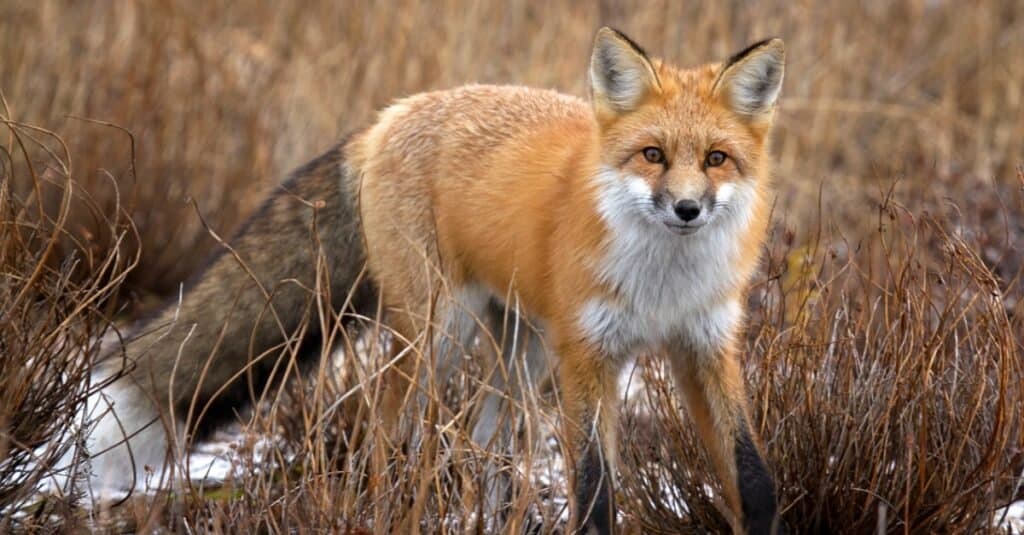Foxes are omnivorous mammals that live on every continent except Antarctica. They are highly adaptable and live in a range of different habitats – from deserts to mountainous regions. Foxes are opportunistic predators and rely on their stealth and cunning when hunting and there is no denying that they are masters at it. But when are foxes most active? It’s often simply assumed that they are nocturnal, but if that’s the case then why do we sometimes see them during the day or early evening? Join us as we delve into the behavior of foxes and discover whether they truly are nocturnal.
Are Foxes Nocturnal?
Most fox species are nocturnal, but not all are. Fox species will be most active at night if their prey is active the or habitats (such as deserts) require it.
Nocturnal behavior is when animals are active through the night and sleep during the day. There are many animals that are nocturnal – such as badgers, coyotes, owls, rats, hedgehogs, leopards, and some insects. There are twelve species of true foxes (genus Vulpes) and around 25 other species which are known as foxes or “false foxes” due to their close resemblance to true foxes.
Whether foxes are nocturnal or not comes down to a few things. Their prey and their habitat are the most important factors. Foxes are opportunistic predators so they are naturally most active when their prey are out and about as it gives them the best chance of catching a meal. If their prey are active at night then so are the foxes. Additionally, their habitat can influence whether they are nocturnal or not. Foxes in the desert are nocturnal because it is too hot for them to be out during the day.
Most, although not all foxes are nocturnal and hunt at night, flitting silently through the shadows in search of food. However, not all foxes are nocturnal. Some foxes are crepuscular while some actively hunt during the day and we’ll discuss these a little later.

Many foxes are nocturnal because that is when their prey is most active.
©iStock.com/Lynn_Bystrom
Advantages of Foxes Being Nocturnal
For the foxes that are nocturnal, there are plenty of advantages that come with it. One of the main advantages is being able to avoid predators. Foxes, like many animals, have predators, and these vary between the different species of fox. It’s a lot easier to remain hidden from a predator under the cover of darkness than it is out in the daylight when they are most exposed. Therefore, for nocturnal foxes daytime is usually spent sleeping in the safety of their den.
Hunting is often easier at night as it’s far easier to move around stealthily in the dark. Foxes have perfected the ability to move around virtually undetected and their highly adapted senses mean that darkness doesn’t hinder them the slightest. They have acute hearing and an incredible sense of smell. Once a fox has detected its prey they can usually pinpoint the exact location and swiftly pounce. Additionally, there is often less competition when hunting at night.
Another advantage of being nocturnal is it means that foxes can, for the most part, stay out of our way. Foxes are naturally wary of humans and will do their best to stay out of our way. Being active at night means that they can do exactly that while still continuing to hunt and carry on with their lives without too much human disturbance.
What is Crepuscular Behavior?
Sometimes foxes are not fully nocturnal but instead are most active at dawn and dusk – the twilight hours. This is known as being crepuscular. Quite often people refer to animals as being nocturnal when they are actually crepuscular because they don’t realise there is a difference.
Some foxes lean towards crepuscular behavior simply because they hunt when their prey is most active. So, if the prey in their particular location and habitat are active during the twilight hours then that is when the foxes will hunt as there is a greater chance of them catching a meal. There are quite a lot of animals that are crepuscular that are on the menu that foxes eat. Many insects are crepuscular, as are some birds and rodents. Snakes and lizards, particularly in desert regions, are also more active during twilight.
As well as prey availability, human interference plays a part in whether foxes are crepuscular or nocturnal. Studies have found that foxes are nocturnal when there is a greater chance of disturbance by humans. However, where there is less human activity (ie in rural locations), foxes are more likely to be active during the twilight hours.

Some foxes are most active during the twilight hours – known as being crepuscular
©Holly Kuchera/Shutterstock.com
Foxes That Hunt During Daytime Hours
Although most foxes are nocturnal or crepuscular, there are still some exceptions to the rule as some foxes do come out during the day. Tibetan foxes are the main exception as they actually prefer to hunt during the day. This is because they mainly prey on plateau pikas. Plateau pikas are small mammals live high up on the Tibetan plateau just like Tibetan foxes. They are diurnal which means that they are active during daylight hours. Therefore, Tibetan foxes are active and hunting during the day rather than night so they can catch their preferred meal.
Arctic foxes are not strictly nocturnal or diurnal as they can be active at any time of the day. They eat whatever they can find and it’s fairly common for them to be hunting during the day. However, it’s not just Tibetan and Arctic foxes that hunt during the day as other fox species hunt during the day if they’re really hungry and food is scarce.
Foxes are also often more active during mating season and spend more time outside of their den. At this point they usually spend at least part of the day lying above ground under tree roots or in any other place with shelter. Not only that, but male foxes roam much more during breeding season in search of females.
At the other end of the breeding season half-grown fox cubs are far more active during the daytime in the summer. It’s common for them to spend quite a lot of time out of the den playing or lying in the undergrowth, or even exploring as they learn to forage for themselves. Therefore, although a lot of foxes are nocturnal, it’s not uncommon for some to be out during the day.
The photo featured at the top of this post is © iStock.com/Hawk Buckman
Thank you for reading! Have some feedback for us? Contact the AZ Animals editorial team.






